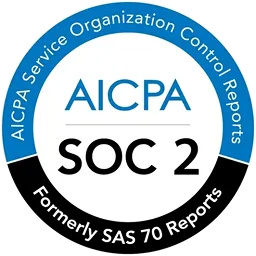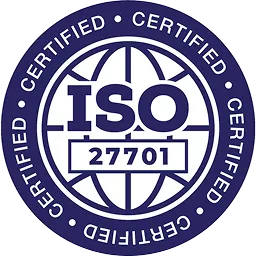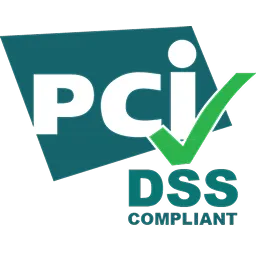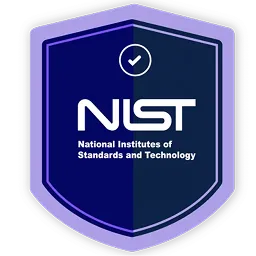Transform your ISO 27001 compliance strategy with automation. In this article, we'll cover everything you need to know about ISO 27001 automation — its crucial role, benefits, the difference between manual and automated approaches, and step-by-step implementation guidance.
With data security and privacy being a key concern for many, clients prefer companies that adhere to regulatory standards like ISO 27001 compliance. As a result, to fit into the standards or expectations, organizations are striving to quickly achieve these certifications to earn clients' trust and improve their market position.
However, obtaining ISO 27001 compliance certification is not as simple as it may seem. It can be quite challenging, especially if organizations have to do everything (enforcing security controls, conducting audits, or conducting risk assessments) independently without any guidance. This is where ISO 27001 automation comes in as a solution.
But what is ISO 27001 automation?
ISO 27001 automation is a process of simplifying the compliance certification process by using automated tools. These tools help identify gaps in an Information Security Management System (ISMS), suggest corrective actions, and facilitate ongoing monitoring of security controls.
This was just a brief overview of ISO 27001 automation; there is more to it, such as its role in achieving ISO 27001 compliance, the benefits of automation, manual vs. automation, and more.
With these detailed insights, you will better understand the ISO 27001 compliance automation concept.
Role Of Automation In ISO 27001
Automation plays a crucial role in efficiently achieving ISO 27001 compliance. But how? It streamlines and simplifies various aspects of the ISO 27001 process, including:
1: Gap Identification
Compliance automation tools can efficiently identify gaps in the Information Security Management System (ISMS) by comparing data against ISO 27001 requirements. How does it work? These tools systematically assess and evaluate your organization's security policies, procedures, and practices.
By comparing these against the mandatory requirements outlined in ISO 27001, these tools quickly highlight areas where the ISMS does not meet the standard. This helps ensure that all aspects of the ISMS are thoroughly checked, minimizing the risk of oversight.
2: Corrective Actions
Compliance automation tools suggest that your team implement corrective measures to address security gaps, improving the effectiveness of security controls. How does it work? This tool automatically detects security gaps and suggests specific corrective actions.
Note: Sometimes, these systems can automatically apply fixes, such as updating configurations or deploying security patches.
3: Continuous Monitoring
Compliance automation tools continuously monitor your security controls, providing real-time insights into compliance status and potential security threats. They track the performance and effectiveness of security controls and changes and also detect deviations.
These insights help your team respond immediately to security issues and provide ongoing assurance that the ISMS remains effective.
4: Documentation
With the help of automated tools, your team can automatically generate and maintain compliance documentation, such as policies, procedures, and audit trails. These tools ensure that all required documents are accurately maintained and easily accessible.
But all these tasks can also be performed manually, so why go through the hassle of implementing automation tools? We've thoroughly compared manual methods and automation tools to provide you with this answer. With these insights, you will clearly understand why there is a shift from a manual to an automated approach.
ISO 27001 Automation vs Manual Method: Which One Is Better?
There are two basic ways of achieving ISO 27001 compliance:
1: By manually performing all the tasks involved in the compliance process
The manual method is a traditional practice that is often time-intensive, tedious, and stressful. But why? This method involves:
- Manually conducting multiple rounds of risk assessments and gap analysis
- Creating policies from scratch
- Designing mandatory controls
Also, you need to train your employees to perform these tasks and make them aware of security best practices.
Furthermore, since all these tasks need to be documented for audit purposes, your team needs to manually update spreadsheets and gather hundreds of screenshots to use as evidence for the audit.
2: Opting for an automated tool to automate most of the compliance tasks
On the other hand, an effective ISO 27001 automation tool simplifies and accelerates the certification process. It eliminates the complexities of manual certification by automating the evidence-collection process, providing expert guidance, and enabling continuous monitoring. In short, with such tools, tasks that usually take months to complete can be accomplished in days.
However, that's not all; the ISO 27001 automation tool also offers other benefits. What are these benefits? Let's find out.
Benefits of ISO 27001 Automation
Listed below are some of the advantages of having an ISO 27001 compliance automation solution in place:
1: Reduces Manual Effort
One of the greatest benefits of using an ISO 27001 automation solution is the significant reduction in manual effort. These solutions automate various parts of the process, including monitoring, conducting risk assessments, evidence collection, and more. They also automate checks and provide real-time updates on missing controls, alerting team members to pending tasks.
They also offer organization-wide visibility into implementation progress, saving valuable administrative time during your compliance project.
2: Controls Compliance Costs
Achieving ISO 27001 certification can be expensive, particularly when the entire compliance management process is done manually. It involves direct costs like consultant fees, legal and training expenses, and indirect costs such as implementing recovery actions.
So, an ISO 27001 compliance automation solution helps minimize these compliance costs, but how?
- Reduces Consultant Fees
Automation tools streamline the compliance process, reducing the need for expensive external consultants. By providing expert guidance and pre-built templates, these tools minimize the time and expertise required from costly consultants.
- Ensures Efficient Resource Allocation
By automating repetitive and time-consuming tasks, these tools allow your team to focus on more strategic activities. This efficient use of resources helps lower operational costs
- Minimizes Training Expenses
Automation tools often come with built-in training modules and resources. This reduces the need for extensive external training programs, allowing employees to learn and adapt quickly at a lower cost.
3: Minimizes Disruption
When the compliance process is handled manually, there are high chances of overlooking potential security gaps due to human error and the tasks' complexity. This can result in the organization becoming non-compliant with ISO 27001 standards and may end up facing legal and financial penalties. That's not all; non-compliance also significantly impacts business operations, disrupting the entire flow of work.
However, with the ISO 27001 automation solution, this challenge can be seamlessly addressed. You can automate the monitoring and assessment processes, which will help detect security gaps without missing any. This way, your organization can minimize the chances of non-compliance, reduce disruption, and maintain proper business continuity.
4: Mitigates of Risk
It is crucial to keep up with evolving security and compliance standards. An ISO 27001 automation solution helps organizations mitigate risks (compliance risks and security risks) through constant monitoring, reducing lapses, and minimizing fines related to non-compliance.
Now that you know the benefits of ISO 27001 automation, let's explore the steps to implement it effectively.
Steps Involved In Implementing ISO 27001 Automation
Below are the steps to implement the ISO 27001 automation solution effectively:
Step 1: Evaluate Your Current Compliance Status
The first step assesses your organization's current compliance status. This involves identifying which security controls or measures are already in place and what specific requirements need to be addressed to achieve full ISO 27001 compliance.
Step 2: Deploy A Compliance Automation Tool And Integrate It With Your Existing System
Next, deploy compliance automation software and set its system up to fit your Information Security Management System (ISMS) framework. Furthermore, integrate the automation tool with all your existing relevant systems to effectively address your organization's unique needs without disrupting the flow of work. Also, make sure to prepare it to manage your specific security processes.
Step 3: Run The Compliance Tool To See Its Effectiveness
Once all the settings are done, you can run the compliance tool and find out if it can help your team identify gaps or weaknesses in your current security measures. Based on these findings, you can check whether it's serving its intended purpose.
Step 4: Create A Plan To Address The Security Gaps & Vulnerabilities Identified By The Tool
If you find that your tool is working effectively, you can use its findings (gaps and vulnerabilities in security control) to create a contingency plan. This plan outlines specific actions that need to be taken across your organization. Each department or team will need to implement these actions. Ensuring everyone understands their responsibilities is crucial for successful compliance.
Step 5: Continuous Monitoring The Security Controls
Your team needs to regularly check if the actions taken to fix security gaps are working as intended. Also, they need to monitor security controls to ensure no deviations or new issues could compromise security. Moreover, continuous control monitoring helps maintain the effectiveness of your security measures and ensures ongoing compliance with standards.
Step 6: Conduct Internal Audit
Conduct an internal audit to check your organization's readiness for certification. This process involves reviewing all security compliance documentation and evidence. Address any remaining issues and ensure all required actions have been completed. This step helps ensure you are fully prepared for the formal certification audit.
Step 7: Apply For Certification
Once you are confident in your compliance status, apply for ISO 27001 certification.
Step 8: Continue With Surveillance Monitoring
After achieving certification, continue to use the automation tool for ongoing monitoring. Regularly review your security measures and address any new gaps or issues that arise. This continuous improvement helps maintain your compliance with ISO 27001 standards and ensures your organization remains secure.
After reviewing the benefits and steps, you may consider implementing a compliance automation platform for your ISO 27001 compliance journey. While many tools are available as an option, the one that can effectively automate your compliance task is Zluri. What is Zluri? How does it work? Here's a quick overview.
Automate Compliance Certification Process Via Zluri
Zluri offers an access review solution that enables your team to automate the certification process easily.

How does it work? Here's how:
Automated Workflows for Access Review
With Zluri's access review, your team can create access review workflows, which allows them to verify who has access to what within the organization.
Further, these workflows can help your team trigger actions to restrict or revoke access if anyone holds unauthorized permissions.
But how does this help comply with ISO 27001 compliance standards?
- Conducts Periodic Reviews
Zluri conducts periodic access reviews to identify and address unnecessary access to critical data. This allows your team to adjust employee access permissions to align with what's necessary, thereby protecting against potential breaches and security risks.
Note: Necessary actions can include enforcing access controls such as role-based access control, just-in-time access, the principle of least privilege, and more.
- Documentation of the Review Process
Zluri's access review documents the entire process, including the actions taken to adjust access rights. This documentation helps demonstrate that your organization maintains effective controls to protect data integrity, meeting ISO standards requirements.
To learn more about Zluri's access review, book a demo now.
Achieve ISO 27001 Compliance Effortlessly With Automation
In conclusion, automating the ISO 27001 certification process can offer organizations several advantages in terms of efficiency, cost control, and accuracy. Also, by automating key aspects of the compliance process with solutions like Zluri, organizations can reduce manual effort, streamline policy implementation, and ensure continuous monitoring and risk mitigation.
This accelerates the certification process, maintains business continuity, and minimizes disruptions. By embracing ISO 27001, automation is a strategic move that enables organizations to achieve and maintain compliance more effectively.
FAQs
1: What Is ISO 27001 Surveillance Audit?
An ISO 27001 surveillance audit is a crucial step in the evaluation process. It is conducted by the certification body to ensure the organization continues to meet ISO 27001 standards. This audit reviews how well the organization has addressed any issues identified in the previous audit. Also, to keep ISO 27001 certification, organizations need to correct any problems found during the surveillance audit.
2: Is ISO 27001 Automation Suitable For All Organizations?
While automation can benefit organizations of all sizes, it is particularly valuable for larger organizations with complex systems and processes. However, even smaller and mid-sized businesses can benefit from automation's efficiency and security improvements.
3: Can ISO 27001 Automation Tool Integrate With Existing IT Systems Of Organizations?
Yes, most ISO 27001 compliance automation tools are designed to integrate seamlessly with your existing IT systems, ensuring a smooth implementation process and minimal disruption to your operations.






.png)
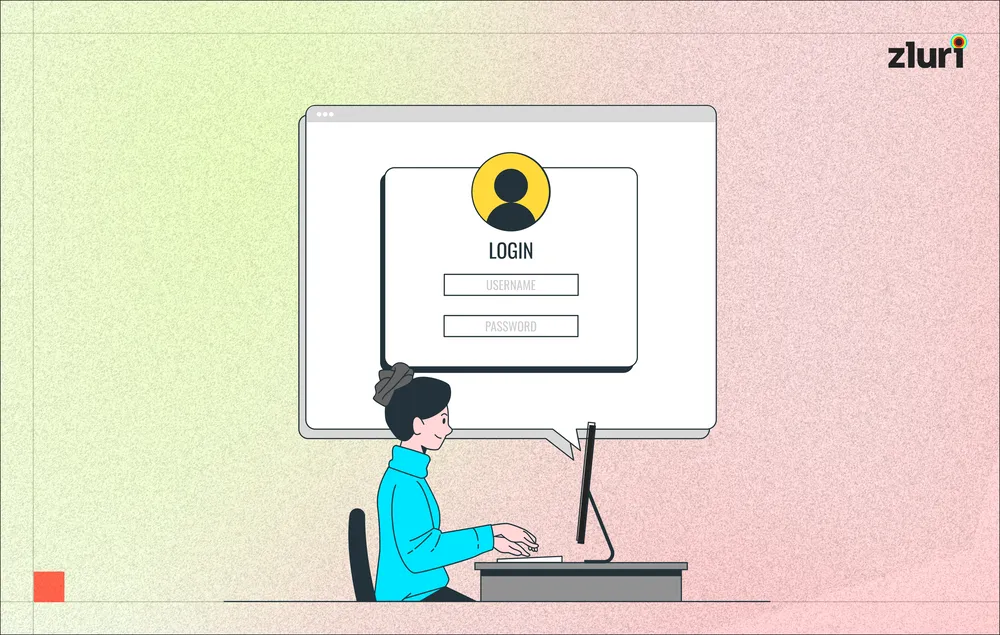

.svg)



